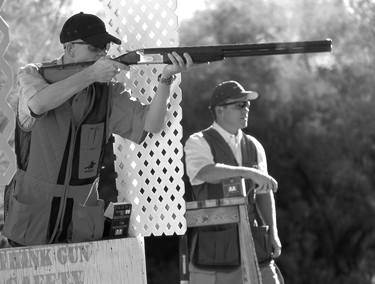
So you’re going to begin reloading. For $250 or perhaps even less, you can get set up with excellent new reloading equipment and buy all of the components you require to begin building your own shotshells. This article will help you get started.

Before you purchase your reloading equipment you will need a place to set up, preferably one where you will not be continuously distracted and where you can be reasonably certain that other hands, especially those of children, will not meddle in the components.
It would also be very helpful if you had a buddy who was also a reloader, because you will have questions, you will make mistakes, and to call the retailer – who may direct you to the manufacturer – is time consuming and can be frustrating.
Begin with a single stage reloader, one that allows you to learn one shell at a time. Look for things that will make your handloading life easier and simpler. If you shoot both the 12 and sub-gauges, you will save more money per shell by concentrating your loading on the smaller guns.
Before you buy, then, verify that the press can be set up to load everything you want to shoot and that it will not cost you hundreds of dollars more to load your 20-gauge and 28-gauge shells, too. It helps to have a press that sizes shells automatically and automatically feeds primers, even if you have to pay a little extra for the primer feed. In short, look for some labor saving features up front. You could end up using this press for darn near forever because its serviceability will not decline with age.
At some time in your shotgunning life, you may become deeply involved with one of the clay sports. As an All American Trap Shooter, for example, you would want to speed up the loading process because you are experienced and you need to build more shells. At that time, you might buy a progressive press, i.e., one that automatically advances hulls through the basic reloading cycle with every pull of the lever.
Do not sell or junk your single stage, though, because it can usually be retrofit to load your hunting shells, which will usually be far fewer in number and different in load character than those required for a trap shooting.
It is better to spend a couple hundred dollars extra up front for the right machine than it is to suffer with years of irritation. Now, let’s go shopping for some reloading equipment.
MEC: MAYVILLE ENGINEERING

Mayville Engineering (www.mecreloaders.com) has manufactured shotshell reloaders under the MEC name since 1956. Everything from the least expensive single stage machine to a fully automated progressive loader is available in the line. (MEC’s Internet site also gives information, prices and parts lists for a number of their discontinued models, thousands of which are still pumping out shells today.)
Beginning with what MEC considers “the world’s top selling reloader” and the very first machine many reloaders use, the 600 Jr. Mark 5 was introduced in 1985 and costs only $118. MEC says that once the operator gains a little experience, this single stage reloader can fill eight to ten boxes of shells an hour. In addition, it can be upgraded with the 285 CA Primer Feed, which eliminates the need to handle each primer individually. This press is adjustable for 3-inch shells and is available in all gauges, plus the .410. All MEC reloaders include one charge bar and three powder bushings:
• 10-gauge (2-ounce bar with bushings 37, 40 and 44),
• 12-gauge (1 1/8-ounce bar with bushings 29, 30 and 32),
• 16-gauge (1-ounce bar with bushings 23, 25 and 29),
• 20-gauge (7/8-ounce bar with bushings 20, 22 and 24),
• 28-gauge (3/4-ounce bar with bushings 14, 16 and 21)
• .410-bore (1/2-ounce bar with bushings 10, 11 and 12, or for a 3-inch shell, the 11/16-ounce bar with bushings 10, 11 and 12).
MEC believes that its Sizemaster reloader is an excellent choice for hunters. The built-in Power Ring Collet Resizer returns all types of shells – with brass or steel bases, high base or low – to factory specifications. The Sizemaster is adjustable for 3-inch shells and fills all gauges and the .410. Additional die sets cost $90 for any gauge except the 10, which is $105. Extra powder bushings are $2.20 and charge bars are $13. An automatic primer feed is standard on the $179 Sizemaster. It loads primers for all gauges, except the 410.
According to Mayville Engineering, the gauge-specific Steelmaster is the only shotshell reloader that is fully equipped to handle steel and lead. The resize head accepts any shell base and the press has an automatic primer feed. Separate presses are required for 10-gauge (1-1/2-ounce bar for BB through #2 with bushings 31, 34 and 37), 12-gauge (2-3/4- and 3-inch: 1-1/8-ounce bar for BB through #3 with bushings 25, 32 and 34) or 12-gauge (3-1/2-inch: 1-1/2-ounce for BB through #2 with bushings 36, 37 and 39A). In the 10- or standard 12-gauge expect to pay about $193 for the Steelmaster, but in the 3-1/2-inch 12-gauge size, the price jumps to $206. Die sets to change gauge cost $90 for any gauge except the 10, which is $105.
Extra powder bushings are $2.20 and charge bars, $15.
The MEC 650N is advertised as “maximum effect for minimum effort” – at the bargain price of just $240. Although it works on six shells at once and finishes a shell with each pull of the handle, the 650N does not resize hulls. If you buy this press, resizing becomes a separate operation. MEC says that the 650N is “the ideal press for the person who likes to resize and inspect their shells as a separate operation.” (MEC’s separate Super Sizer shell resizer costs $67. It is built-in to all “new generation” MEC reloaders. Separate parts must be purchased to resize different gauges.)

The 650N press uses three crimping stations. The first one starts the crimp and the second closes it. The final station places a very slight taper on the shell, which allows it to feed easier through pumps and semi-autos.
Other features of the 650N however make it more attractive. The automatic primer feed is standard, for instance. This press is available in all gun sizes, but die sets to switch one machine between gauges are not available and the 650N does not load 10-gauge shells.
MEC’s progressive 8567 Grabber mechanically programs 10 operations at six stations. This $338 reloader has a fully automatic primer feed, auto-cycle charging and the three-stage crimp mentioned above. The built-in Power Ring resizer operates without interrupting the reloading sequence. The operator manually places hulls and wads in the proper place and a finished shell is subsequently produced with each pull of the handle. Optional kits are available to load 3-inch and steel shells. (The 8567 is not available in 10-gauge.)
The 9000-Series is MEC’s top-of-the-line progressive press with plenty of automatic features, such as primer feed. The $407 model #GN is hand-powered while the $958 #HN is hydraulic and operates via a foot pedal. These machines incorporate all of the 8567’s features including automatic resizing, automatic indexing and finished shell ejection after final crimping. The 9000-Series does not reload 10 gauge shells and die sets are not available.
MEC has a number of press accessories available such as a dust cover, larger capacity primer feed tray, jig fixture and intermediate bottle supports. Note that a steel shot kit and charge bar must normally be installed to reload steel shot.
PONSNESS/WARREN (P/W)
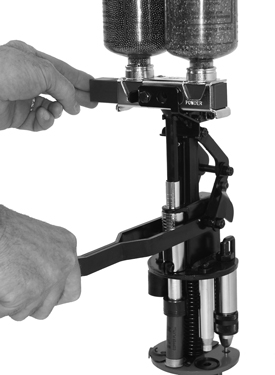
Ponsness/Warren (www.reloaders.com) has developed reloading gear for almost 40 years and its Platinum 2000 Series progressive reloading presses are state-of-the-art. The 2000s feature P/W’s typical cast frame and precision-machined parts. With eight shells in separate stations and various stages of completion, a 2000 automatically performs the following functions with each pull of the handle: indexes the shells, de-primes and re-primes, drops a precision volume of powder, inserts the wad, then drops a precision volume of shot, crimps the shells and finally ejects a completed shell.
The author of the previous edition of this venerable volume called P/W reloader’s full-length re-sizing dies their “very best feature.” With a P/W 2000, the shell is pressed into a sizing die at the very first station and it rides through the balance of the process contained within this steel ring. In this system, a hull rarely distorts, and as much pressure as necessary can be applied for proper crimp closure.
P/W is especially proud of the hopper and the primer feed on these machines. Their EZ-Fill Access Hopper holds more than 25 pounds of shot and up to a pound of powder in a high-impact plastic divided container. When you need to load several different recipes, special bushing-access holes allow quick shot and powder bushing changes without the usually laborious task of draining and removing hoppers. Purchased separately, it is $90.
The brass external primer feed allows an operator to easily adjust primer seating depth without taking the primer feed assembly out of the machine. Primers are held in a tray, approximately at eye level, and are fed downward through a sleeve into the feed assembly by gravity. Purchased separately, the primer feed is $100.
A Lifetime Warranty on the index system and P/W’s new Die Removal Cylinder come with this series of presses. P/W says the Die Removal Cylinder is built with 100 percent Grivory®, which it says is “a new compound that is stronger and more rigid than aluminum.” It allows you to easily remove and inspect shells during the reloading process to check powder or shot weights, by simply lifting a die pin and sliding out the shell. The 3-pound Die Removal System is also available to update many older P/W reloaders. It costs $170 and comes with the P/W shell extracting kit.
A 52-pound Platinum 2000 with sizing die system is available in 12-gauge (powder bushing H, shot bushing #6 for 1-1/8-ounce), 20-gauge (powder bushing D, shot bushing #4 for 7/8-ounce) and 28-gauge (powder bushing B, shot bushing #3 for 3/4-ounce), as well as the .410-bore (powder bushing 2A, shot bushing #1 for 1/2-ounce). They have a catalogued price of $699, although the factory’s 2004 Christmas Special flyer offered them for $649 and you can undoubtedly buy them for less through a reputable internet source. (Of course, if you buy through a local retailer, you may not pay the rock-bottom price. You will almost certainly, however, have access to friendly and helpful technical assistance when you run into difficulties or have questions that are not covered on the manufacturer’s Internet site. And you will have questions.)
The P/W 800 Plus was new for 2004. Built with full-length resizing dies and a gear-style index system, this progressive machine sounds an audible “click” when it is fully indexed. (Because I always worry about proper seating and positioning of mechanical elements, I like this small feature.) A die-removal cylinder allows for easy shell removal at any station. The 800 Plus uses the EZ-Fill Access Hopper and all other standard features of a 2000. Lacking a central shaft, 800 Plus tooling kits are installed in a tool head. This allows you to convert to another gauge in about five minutes without the need to readjust any of the crimping stages.
The 52-pound 800 Plus with sizing die system is available in 12-, 20- and 28-gauge as well as .410-bore with a catalogued price of $699 and the same powder and shot bushings as those listed for the 2000 Series. The 2004 Christmas Special flyer from the factory offered these reloaders for $649! Individual gauge-specific tooling kits cost an extra $295.
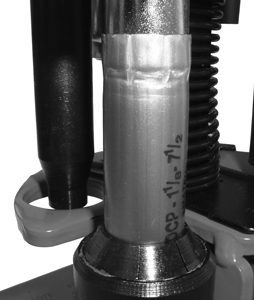
P/W says their 53-pound L/S-1000 is the “only fully progressive reloader that loads lead, steel and bismuth shot without the need for any type of conversion kit.” This press features a silent indexing system and the company’s new Grivory Die Removal System. The precise Uni-Drop System on the L/S-1000 drops any shot size, up to and including BB. The 12-gauge model ($849) loads either 2-3/4- or 3-inch shells while the 10-gauge model ($895) loads only 3-1/2-inch.
The single stage reloader in P/W’s current press line-up is the Du-O-Matic 375C. Like the larger and more expensive L/S-1000, the Du-O-Matic will load lead, steel or bismuth without requiring a conversion kit. The dual tool head lets you install a second tooling set when you want to change gauge. Look for extra large shot and powder tubes, which include baffles and a positive-lock charge ring that prevents the accidental flow of powder. A positive, full-length resizing die contains the shell throughout the loading operation. Your shell always emerges bulge-free. A 31-pound Du-O-Matic is available in all gauges plus the 410 bore. Expect to pay around $300 if you purchase it direct from Ponsness/Warren, except for the 12-gauge/20-gauge model, which is $384.
Ponsness/Warren offers a large number of options and accessories for its reloading presses such as dust covers, shell counters, shovel handles, a new finished-shell Front Drop collection system and multiple types of conversion kits that allow older P/W presses to load non-toxic shot. Its top-mounted Automatic Shell Feed System is available for those who quickly tire of feeding shells manually, one by one. The Shell Feed holds 500 empty shells, and sends them brass-down onto the shell feed seating assembly. An electric motor, which turns the sorting disc in the hopper, is equipped with a micro-switch that stops the motor automatically when the feed tube is full (30 pounds, 12-gauge only, $395 0r thereabouts).
About the time your eyes glaze over and you’re sure that you will soon turn up three cherries from cycling the press handle, you will be willing to spend $899 for P/W’s Hydro-Multispeed, single cylinder hydraulic system. With a floor-mounted pedal, this 65-pound hydraulic system permits hands-free reloading. It has three speed settings and P/W guarantees that it will not damage your P/W reloader with high pressures. Extra-long hoses with quick-disconnect couplings allow for floor placement of the motor. An optional cylinder kit allows you to hook up your Hydro-Multispeed assembly to more than one press for loading multiple gauges or recipes at one time (9 pounds, $400).
LEE PRECISION

The Lee reloading business took off from the home workshop of Richard Lee in 1958. In that year, Lee invented the famous Lee Loader. Additional Lee Loaders for rifle and pistol ammunition came along in the early sixties. Lee says that their “effective and economical tools have introduced more than one-and-a-half million shooters to reloading.” Then, in the mid-70s, the well-known Lee Load-All hit the market, establishing Lee as a household name in handloading circles. Lee equipment is unconditionally guaranteed for two years. In addition, any Lee loader of current manufacture, regardless of age or condition, can be returned to the factory for “like new” reconditioning, including a new guarantee, for half the current retail price.
The popular and inexpensive $49.98 Lee Load-All II single-stage press works for lead or steel shot in 12-, 16- and 20-gauge (www.leeprecision.com). The spent primer-catcher is built-in and conveniently empties in the front. Recesses at every station allow positive shell positioning. Gauge conversion is easy and economical by simply replacing the die carrier ($20). An optional primer feed ($10) means that you never have to touch the primer from the box to the shell. Each new purchase includes twenty-four red plastic shot and powder bushings. The bushings are visibly indexed and this keeps neophyte reloaders from confusing shot and powder charges.
What has given the Load-All II its reputation is the extreme ease with which it operates. Work your way from left to right and follow a pamphlet’s illustrated instructions. (I found the loading advice a little more abbreviated than I would have preferred, however.) Adjustments are simple – some would say primitive – but straightforward, which might confuse digital children. Nevertheless, you will understand the fundamentals of each step without having to muddle through much extraneous clutter.
If used with patience, the Load-All II can make excellent reloads for 2-3/4- and 3-inch shells, high or low brass bases with six- or eight-crimp closures. The Load-All II is not however sized to build 3-1/2-inch shells because the die set is not deep enough to reach the base of the loader with a shell that tall in the die set. Therefore, proper sizing on 3-1/2-inch shells cannot be accomplished. Of course, this press is not a racehorse and it can teach you to work methodically. If you do not push this machine beyond its limits, you will have a productive press that you can enjoy for many years. Lee does not build a progressive reloader, or a press that will handle the 10- or 28-gauge or the 410.
DILLON
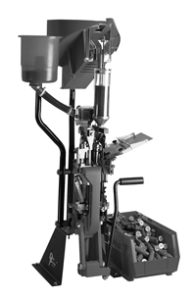
Dillon writes that their SL 900 features “easily adjustable, case-activated powder and shot systems that eliminate troublesome bushing changes along with spilled powder and shot.” According to Dillon (www.dillonprecision.com), the built-in adjustable powder measure is good to within 1/10 of a grain and the shot hopper holds 25 pounds! There are no bushings for shot or powder to deal with in this Dillon machine. This, in itself, is a hugely attractive feature. The automatic indexing SL 900 loads 12-, 20- and 28-gauge shells and by switching tool-heads, you can switch gauges without having to reset your dies and measurements. The case feed and priming systems are automatic. The basic SL 900 is $646. You can spend another $174 for a case-feeder and $263 for the conversion package to load another size shell.
RCBS
RCBS is part of the ATK (Alliant Techsystems: (www.rcbs.com) Ammunition & Related Products Group with Federal Cartridge and Alliant Powder.
The new, 7-station single-stage RCBS Mini-Grand is designed for entry level reloading of lead or steel (with the appropriate steel accessories) and its hopper holds 1/2-pound of powder and 12-1/2-pounds of shot. The Mini-Grand is available in a 12-gauge version to load 2-3/4-, 3- and 3-1/2-inch shells. The 20-gauge press will accommodate 2-3/4- and 3-inch shells. Using RCBS, Hornady or Ponsness-Warren powder and shot bushings, the Mini-Grand is capable of loading 200 hulls (8 boxes) per hour.
An optional taper crimp die is available for the Mini-Grand. This reloader comes with a Lifetime Warranty. At Christmas 2004, the Mini-Grand was $125 from RCBS or $100 from Graf & Sons at www.grafs.com. (An optional $18 dust cover is an excellent idea for a machine as complex as any shell press, especially if it is mounted in a room without constant temperature and humidity controls.)
The progressive shotshell loader in the RCBS line is The Grand. It is available for 12- or 20-gauge shells at $724. Conversion kits to switch between 12- and 20-gauge reloading cost $336. The 8-stage Grand is “intended for the shotgunner who requires accurate, precision shotshells for hunting or trap and skeet,” RCBS says. “The operator merely has to start a hull at station one and insert a wad in the wad guide at station four. All other functions are performed automatically. Once in full operation, a loaded shotshell is dispensed each time the handle is cycled through the full down-and-up strokes.”
The shot-drop and powder-drop systems are case-activated and will not drop shot or spill powder unless a hull is properly in place. With the powder-drop station at the front, it is easy to remove the hull to weigh powder if you suspect an error has been made. The powder charge bar also accepts Hornady bushings. The Grand’s powder hopper holds one pound; the shot hopper holds 25 pounds; and its steel resizer ring will work with either high- or low-base brass. Its cast aluminum frame is held together with steel rods and links.
A Hydraulic Conversion Kit to convert The Grand to full hydraulic operates with two foot switches, one for up and one for down. Releasing pressure on the switch automatically stops the operation of the press. The unit features quick-disconnect hoses and is capable of boosting operation to a whopping 660-shells (26+ boxes) per hour. RCBS says that complete installation only takes between 15 and 30 minutes. This unit costs $900.
SPOLAR POWER LOAD
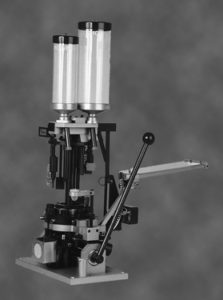
With a gold anodized finish and handsomely crafted construction, the Gold Premier is rated very high for workmanship. At $1,295 for a single gauge, the machined aluminum Spolar Gold progressive loader (www.spolargold.com), originally designed by the late trap shooting champion Frank Simpson, costs much more than other top shotshell presses and plenty of adequate shotguns, too. If you still have a few extra bucks after paying for your reloader, you can add a foot-operated hydraulic mechanism with quick-disconnect hoses for an additional $995. Spolar says its hydraulic operating system allows a completed shell to fall into your shooting box every three seconds and you can set up the hydraulics and hoses in 10 minutes or less. After this, you may still want to add $265 for gauge changing materials and $580 for a custom reloading table.
If quality construction is important, you will enjoy the fluid movement made possible by closely machined tolerances and sealed ball bearings in many of the moving parts. Left-handers will appreciate the ambidextrous nature of the Gold’s left- or right-side handles, too. An exceptional feature of the Gold Premier is that it can be disarmed and everything halted during a loading cycle. Dies are removable of course, and the charge bar can be unhooked without spilling shot and powder.
The Spolar Gold Premier is loaded with features. It has a vibrating electronic shot, powder and primer settling system. All four of the competition gauges – 12, 20, 28 and .410 – are available and they can be changed in less than five minutes without making extra adjustments to your settings. Shells can be removed at any station, and your wad and shot drop almost simultaneously. This machine has a locking system to prevent any unauthorized meddling. The Gold has a 25-pound shot capacity and comes with a shell counter. Spolar says they are the only manufacturer that loads “a minimum of 100 factory test rounds with your recipe prior to shipping” a unit to you.
HORNADY
You can buy a Hornady 366 progressive reloading press in 12-, 20-, 28-gauge or .410-bore for $430 from www.outdoorguides.com. Look for additional information on the Hornady site at www.hornady.com. Nevertheless, the 366 features full-length base and hull resizing, automatic primer feed, swing-out wad guide, three-stage crimping, automatic advance and automatic ejection of the finished shell. For $180, you can purchase die sets for additional 2-3/4-inch shells in other gauges. Additional lead shot bushings are $6.
LYMAN
In 1878, William Lyman invented the tang-mounted peep sight. That was the birth of Lyman Products and today, 125 years later, the company (www.lymanproducts.com) includes Pachmayr, Trius, TacStar and A-Zoom.
To be confident in your reloading, you must have an accurate scale and, in this area, cheap is inexcusable and contains the seeds of unhappiness. Of course, your shot bar and bushings should give you the confidence that they are correct, but what about that afternoon that the kids keep barging in to your reloading shrine or you have a grudge against your spouse? Are you certain you can proceed without being distracted? Did you double-check ingredient weights now and then for each recipe you loaded?
A 1,000-grain powder scale works extremely well, adds very little noticeable time to the overall loading procedure and permits greater accuracy of your weights and measures. You also use an accurate scale to give you peace of mind and keep your spouse from collecting on the insurance. Here is an example of why a precise scale is useful.
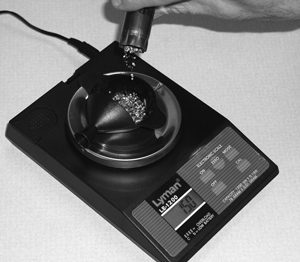
Steel shot bushings are available for most reloading presses, but they may be thought of as limited-application tools. Smaller pellets work as indicated and will flow through bushings well. Large steel pellets are often difficult to volumetrically meter through a bushing, however, as they seem to hang up wherever they can. Nobody makes so many hunting loads with large pellets that they should not be able to take the time to weigh each pellet charge.
The comparisons hunters often make to lead shot loads seem to compel them to overload steel. Hunters have, for years, assessed load application by payload weight and have associated certain weights with a lethal hunting load. For example, everyone knows that 1-1/8 ounces of lead is a target load, right! However, 1-1/8 ounces of steel is a magnum payload, the pellet equivalent of around 1-1/2 ounces of lead. For a 12-gauge, a 1-1/2-ounce load is a magnum, by anyone’s definition. (Actually, this misapplication of low velocity, high volume steel shot loads is somewhat to blame for steel shot’s poor image.)
So here are a couple of Lyman scales that are excellent for the reloading bench. The LE-1200 Electronic Scale has a 1,200-grain-weight capacity, powder pan, calibration weight and digital display. It will work equally well with shotshells and for rifle or pistol cartridge reloading. One touch converts it to metric (gram) mode and its compact size makes it almost inconspicuous on your loading bench. Power is available through a wall outlet or a 9-volt battery (not included). Order direct from Lyman and you will pay $265 for the LE-1200.
The LE-800 is a slight step down, although it actually measures up to 850 grains, not just 800. The LE-800 works on AAA batteries, and a set is included. The smaller scale is $183.
Lyman has several suggestions that will help you get accurate readings from their electronic scales. First, scales should always be used in an area free of air currents. Second, each time you use it in a new reloading session, go ahead and recalibrate. Because Lyman electronic scales operate at the touch of a finger, this only takes a few seconds.
Next, if you move your scale into a new room that may have a different temperature and/or humidity, the company suggests letting the scale stabilize for a half hour before zeroing and calibrating. Speaking of recalibrating, each scale comes with a set of instructions beginning, “Do not calibrate the scale with the powder pan on the platform, as this will cause incorrect programming.” The Lyman website includes detailed instructions for each model scale.
If you are of the old, pre-digital dinosaur order when batteries were not required to operate all of your toys at Christmas, you may want one of the Lyman Mechanical Beam Scales. The 2-pound Model 500 offers 505-grain capacity and is accurate to 1/10-grain. It offers “positive pan positioning and magnetic dampening” for $73. Step up to the Model 1000 mechanical and you can measure up to 1,005 grains with the included scale counterweight.
MISCELLANEOUS GEAR

Hull Marker: Have you ever fished in your pocket and pulled out a reload and not really been certain what it was? Was it a #6 or is it an #8-1/2? This could be a problem on the skeet range and when bird hunting, too. You can avoid mixed up or mismarked shells with a hull identification stamp kit. You could also apply a color-coded sticker from an office products store (to the base perhaps, not on top of the crimp where a sticker might change the load’s pressure parameters) or you can just experiment with indelible inks to see which felt-tipped pen works best. Whatever you choose, marking your reloads is an excellent idea, especially if you load more than one type of shell and have trouble keeping things straightened out.
Hull Skiver: Hull skiving removes a thin layer of plastic from the mouth of the hull and tapers hull openings for easy component placement and better fold crimps. The aluminum oxide abrasive coating is long lasting. Buy the Skiver for $10 or simply or carefully use the fine-grit sandpaper from the garage.
Roll Crimping: Handloaders sometimes rely on a six- or eight-fold crimp when a roll crimp would be better, say the experts at Ballistic Products (www.ballisticproducts.com).
Factory ammo uses fold crimps because the process is dictated by high-speed machinery. As a reloader, you can choose based on performance rather than on someone else’s convenience. Roll crimped shells are especially excellent for buckshot and slugs or sabots, for heavy payloads and any custom hull lengths. They also give consistent closure resistance and deliver consistent chamber pressures.
With the right tools, roll crimps are easy to build and your shells look pretty darn good when they are finished. Roll crimps are made with a special bit that, through a combination of heat and pressure, turns over the final 1/4 inch of a hull inward and down, until the edge contacts the overshot card that sits on top of the payload. The roller that makes the crimp is about $30 and it is specific by gauge. A special hull vise to hold the shell is about $40 and, considering the aggravation in dropping or spilling, may be well worth the cost.
This article is an excerpt from Reloading for Shotgunners 5th Edition.

Next Step: Get your FREE Printable Target Pack
Enhance your shooting precision with our 62 MOA Targets, perfect for rifles and handguns. Crafted in collaboration with Storm Tactical for accuracy and versatility.
Subscribe to the Gun Digest email newsletter and get your downloadable target pack sent straight to your inbox. Stay updated with the latest firearms info in the industry.

![Best Concealed Carry Guns In 2025 [Field Tested] Wilson Combat EDC X9S 1](https://gundigest.com/wp-content/uploads/Wilson-Combat-EDC-X9S-1-324x160.jpg)


![Best 9mm Carbine: Affordable PCCs [Tested] Ruger Carbine Shooting](https://gundigest.com/wp-content/uploads/Ruger-Carbine-Shooting-100x70.jpg)
![Best AR-15: Top Options Available Today [Field Tested] Harrington and Richardson PSA XM177E2 feature](https://gundigest.com/wp-content/uploads/Harrington-and-Richardson-PSA-XM177E2-feature-100x70.jpg)
